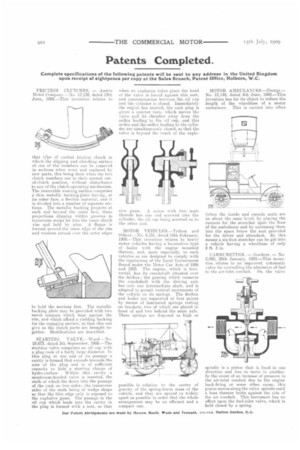Patents Completed.
Page 20

If you've noticed an error in this article please click here to report it so we can fix it.
Complete specifications of the following patents will be sent to any address in the United Kingdom upon receipt of eightpence per copy at the Sales Branch, Patent Office, Holborn, W.C.
FRICTION CLUTCHES. — Austin Motor Company.—No, 12,138, dated 13th June, 1908.----This invention relates to that tjpe of conical friction clutch iii which the slipping and clutching surface of one of the members can be removed in sections when worn and replaced by new parts, this being done when the two clutch members are in their normal outof-clutch position, without disturbance to ally of the clutch-operating mechanism. The removable wearing surface comprises a thin metallic backing-plate having, at its outer face, a flexible material, and it is divided into a number of separate sections. The metallic backing projects at each end beyond the outer face, these projections slipping within grooves in transverse strips let into the inner clutch rim and held by pins. A flange is formed around the inner edge of the rim and washers extend over the outer edges
to hold the sections firm. The metallic backing plate may be provided with two metal tongues which bear against the rim, and which afford a yielding backing for the engaging surface, so that this can give as the clutch parts are brought together. Modifications are described.
STARTING VALVE.—Wood.—No. 18,673, dated 5th September, 1908.—The starting valve comprises an oil cup with a plug cock of a fairly large diameter. in this plug at one end of its passage a i cavity s formed that extends towards the axis of the plug and is of sufficient capacity to hold a starting charge of hydro-carbon. Within this cavity a mushroom-headed valve is inserted, the stalk of which fits down into the passage of the cock on two sides ; the transverse sides of the stalk being of wedge shape so that the thin edge only is exposed to the explosive gases. The passage in the oil cup which leads into the cavity in the plug is formed with a scat, so that
when an explosion takes place the head of the valve is forced against this seat, and communication between the oil cup and the cylinder is closed. Immediately the engine has started, the cock plug is given a quarter turn, which MOVOM the valve and its chamber away from the. orifice leading to the oil cup, and this orifice and the orifice leading to the cylinder are simultaneously closed, so that the valve is beyond the reach of the explo
sive gases. A union with two male threads has one end screwed into the cylinder, the oil cup being screwed on to the other end.
MOTOR VEHICLES.—Trittort and Others.—No. 4,151, dated 19th February, 1909.—This invention relates to heavy motor vehicles having a locomotive type of boiler with the engine mounted thereon, and, more especially, to such vehicles as are designed to comply with the regulations of the Local Government Board under the Motor Car Acts of 1896 and 1903. The engine, which is horizontal, has its crankshaft situated over the firebox ; the gearing which connects the crankshaft with the driving axle has only one intermediate shaft, and is adapted to permit vertical movements of the vehicle on its springs. The firebox and boiler are supported at four points by means of laminated springs resting on brackets, two of which are placed in front of and two behind the main axle. These springs are disposed as high as possible in relation to the centre of gravity of the spring-borne mass of the vehicle, and they are spaced ER widely apart as possible in order that the whole arrangement may be an efficient and a compact one.
MOTOR AMBULANCES—George.No. 12,149, dated 4th June, 1908.—This invention has for its object to reduce the length of the wheelbase of a motor ambulance. This is carried into effect (when the inside and outside seats are on about the same level) by placing the runners for the stretcher upon the floor of the ambulance and by exteinumg them into the space below the seat provided for the driver and attendant. By this means a six-foot stretcher can be got into a vehicle having a wheelbase of only 8 ft. 3 in.
CARBURETTER. — Gardner. — No. 2,090, 28th January, 1009.—This invention relates to an improved automatic valve for controlling the admission of fuel to the air-inlet conduit. On the valve spindle is a piston that is fixed in one direction and free to move in another. In the event of an increase of pressure in the air-inlet conduit due to the engine back-firing or some other cause, this piston moves along the valve spindle until a boss thereon butts against the side of the air conduit. This movement has no effect upon the fuel-inlet valve, which is held closed by a spring.




















